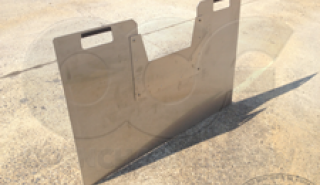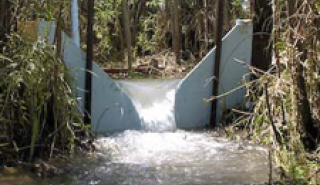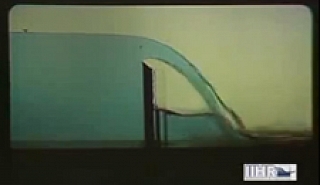There is a lot of confusion as to what materials are suitable for making a thin-plate weir from. Some installations use plywood, some stainless steel, some painted steel, and other fiberglass or aluminum.
In making a weir plate the most important consideration is the weir crest. The thickness of sharp-crested, thin-plate weir crest must be no more than 1/8-inch [0.3175 cm]. Thicker than this and the likelihood exists that the nappe, the water flowing over the weir crest, will not spring free of the downstream face of the weir. When this happens the weir is not aerate and the weir may misread the actual flow rate by as much as 25%.
A weir crust must hold its shape and be resistant to abrasion, nicks, and burs. Over extended periods of time, rounding of the upstream edge of the weir crest is also of concern. As soon as rounding, abrasions, burs, or nicks are detected on a weir’s crest, they should be corrected. Care must be taken, though, to ensure that the geometry of a weir’s crest not be altered – burs should only be flattened until they no longer stick up / out. No attempt should be made to remove any additional indention in a weir’s crest, as this will change the weir’s geometry.
Where the thickness of the weir material is greater than 1/8-inch [0.3175 cm] the downstream edge must be beveled from 45-60 degrees to obtain the proper weir crest thickness. Due to the difficulty in maintaining them, and potential danger in using them, weir crests should not be knife sharp.
Plywood Weir Plates
Attempts have been made to use plywood as a material of construction for weirs. Unfortunately at the request thickness, plywood is brittle, prone to splitting, and can be rough. Additionally, swelling due to water absorption is also a concern. Where plywood must be used, it should only be as a weir plate carrier and not the weir itself. A stainless steel weir plate should be attached to the plywood over which flow should pass.
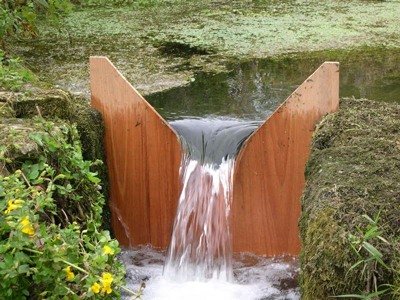
Galvanized / Painted Steel Weir Plates
Galvanized steel and painted steel are typically not uses as weir materials, in part due to the ease with which the protective coatings (zinc galvanization and paint respectively) are eroded or penetrated on so thin a surface as a weir’s crest. Once the protective coating is bypassed, rust and scaling are quick to set in – both of which increase the weir crest’s roughness and affect flow readings.

Fiberglass Weir Plates
In clean water applications (applications where abrasive grit or debris are not present), fiberglass weir plates may be used. Here the material is usually 1/4-inch [0.635 cm] thick, with the downstream edge beveled to a 45 degree angle to yield the desired 1/8-inch [0.3175 cm] crest thickness.
The stock material for fiberglass weir plates can be pultruded flat stock or hand laid fiberglass. When using pultruded fiberglass, care must be taken in properly beveling the downstream face of the weir crest. In hand laid fiberglass the weir plate is usually formed as one piece with a custom formed notch directly molded into the weir plate.
Pultruded weir plates are smooth on both sides; while hand laid weirs are smooth on the upstream side and satin smooth or slightly patterned on the downstream side (where the fabricator rolls out the resin soaked fiberglass to remove air bubbles and consolidate the laminate).
Aluminum Weir Plates
Aluminum is a relatively soft metal (when compared to stainless steel). In a method similar to that of fiberglass, an aluminum weir plate is usually fabricated from 1/4-inch [0.635 cm] material and then beveled to give the desired crest thickness. Beveled to 1/8-inch [0.375 cm] thickness, aluminum must be handled with care or damage will occur to the weir crest. Unlike stainless steel, which can be cut from1/8-inch [0.375 cm] thick material and still retain sufficient strength / toughness, aluminum requires the additional stiffness that material thickness that 1/4-inch [0.635 cm] provides.
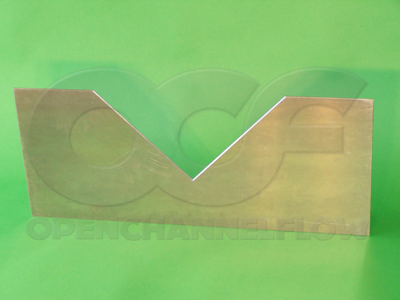
Aluminum does have the advantage of being very light weight, making its portability good and transportation costs low. Machine shop milling is required, though, resulting in a weir that is frequently more expensive than a similar sized unit in 1/8-inch [0.375 cm] thick stainless steel.
Concrete Weir Plates
Concrete is not a suitable material from which to form a sharp-crested, thin-plate weir. Concrete provides too rough a surface and is difficult to form and maintain at the required thickness of a weir crest. Where concrete is used, it should only be used as a baffle to direct flow over the weir. The weir itself is usually stainless steel attached to the upstream surface of the concrete wall. To ensure that the nappe springs clear of the weir crest, the weir plate either be set high enough so that the water does not impact the downstream notch in the concrete wall, or the downstream notch in the concrete wall must be beveled.

Stainless Steel Weir Plates
T-304 stainless steel weirs have become the standard – both as stand alone portable units and as weir plates attached to other materials. Stainless steel weir plates can be heavy in larger sizes. Here a weir wall (or carrier) is usually formed or otherwise installed perpendicular to the direction of flow so that water is funneled through a notch in the wall. Over this notch a stainless steel weir plate is attached for the water to actually flow over.

In portable applications, both the weir plate and the weir carrier are fabricated in stainless steel to provide toughness and high strength. Here the weir plates may actually come in a set to allow for the selection of an appropriate weir plate to fit a site unique anticipated flows – versus trying to apply a given weir angle when it is cut directly into the weir carrier.

Image: Clemson University



